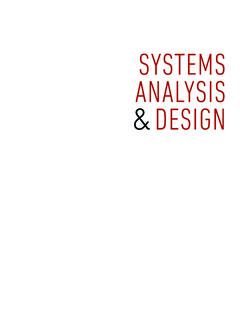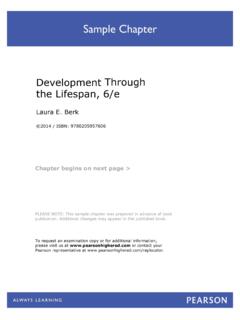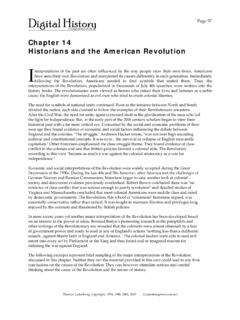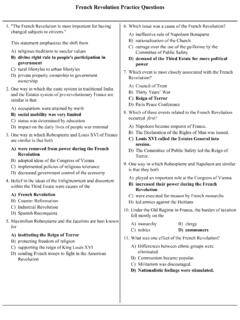Transcription of Introduction to Social Studies Education - Pearson
1 PART ONEI ntroduction toSocial StudiesEducationChapter 1 Social Studies Education : What and WhyChapter 2 Teaching Diverse Children94941 01 001-027 r1 sp 2/18/11 4:43 PM Page 1 Chapter 1 Social Studies Education :What and Why Social Studies Social understanding Civic efficacy Curriculum goals Scope and sequence Curriculum standards Grade and unit topics Conceptual themes Achievement gap 21st century skills TrendsKey ConceptsChapter for Social Studies : Social Understandingand Civic Scope Standards: national , State, Key THISAs they enter the classroom, the kindergarten children are excited to find a large strip ofpaper going down the middle of the floor. Their teacher, Jacob Stern, tells them to hangup their coats and come sit beside the paper strip.
2 The strip, hetells them, is a highway connecting two distant towns. Mr. Sterntakes a toy car and starts driving it along the highway. Whatmight happen as someone drives along? he asks. The childrensuggest a number of possibilities: running out of gas, gettingtired, and being hungry. What services might be necessaryfor people as they drive from town to town? Tanisha sug-gests a gas station. A milk carton is placed along the highwayand named Tanisha s Gas Station. 194941 01 001-027 r1 sp 2/18/11 4:43 PM Page 2 When I was in elementary school in Englewood, Colorado, just south of Denver,I loved Social Studies . I had brilliant teachers, and they taught us Social stud-ies every day, every week, and every month.
3 It was serious Social Studies , not socialstudies lite. They introduced us to the knowledge and skills of the Social scienceswhile preparing us to hold the highest office in the land: citizen. It was challenging,it was fun, and it was with Social Studies material that my reading and writing of us from Lowell Elementary School appeared to our middle schoolteachers to be the smart kids, which was not the case; we were just well taught. Priorknowledge always makes a student look smart. Our elementary teachers gave us thatgift: By the time we got to middle school, we already knew something about whatthese new teachers wanted to teach us. We had a foundation they could build on. Bestof all, the teachers at Lowell didn t simply load us up with facts and skills.
4 Theytaught us ideas and ignited a lifelong interest in experience in elementary school fueled more than my love of Social studiessubject matter. It also fueled my interest in how children can develop a solid founda-tion in Social Studies before they go on to middle and high school. I think of thatoften, and it pervades this book. In the primary grades (kindergarten 3rd), whatshould children be learning about Social Studies ? And then how can they best buildon that in the intermediate grades (4th 5th)? And then in the middle grades(6th 8th)? Simply put, Social Studies Education is powerful, and not having access toit, for whatever reason, is disabling intellectually, socially, and historical understanding, there can be no wisdom; without geographi-cal understanding, no cultural or environmental intelligence.
5 Without economicunderstanding, there can be no sane use of resources and no rational approach todecision making and, therefore, no future. And without civic understanding, therecan be no democratic citizens and, therefore, no is why Social Studies Education matters. When children are empowered byknowledgeable and skillful teachers with the information, ideas, skills, and attitudesand values that compose the Social Studies curriculum, their judgment is , they can reason historically, help solve community problems, embracediversity, fight intolerance and bigotry, protect the environment, and, with deepunderstanding, empathize with the hopes, dreams, and struggles of people IDEAThe purpose of Social Studies Education is to helpstudents develop Social understanding ( , knowledge of people andplaces near and far [geography] and now and then [history])
6 And civicefficacy ( , the ability to think and act as a democratic citizen in adiverse nation and an interdependent world).394941 01 001-027 r1 sp 2/18/11 4:43 PM Page 34 Chapter 1 Social Studies Education : What and WhyGoals for Social Studies : Social Understanding and Civic EfficacyThere are two primary goals of Social Studies Education , and they are the guidinglights of most Social Studies curriculum standards. Standards, as we will see laterin this chapter and throughout the book, are statements that describe what studentsshould learn the desired results of instruction, also called objectives. But curricu-lum standards whether national , state, or local school district standards are notto be confused with the broad goals or purposes of curriculum and instruction.
7 Stan-dards make no sense unless we know the goals they are aiming to achieve. To get atthe goals of Social Studies , let s begin with a to the national Council for the Social Studies (NCSS), Social Studies .. is the integrated study of the Social sciences and humanities to promote civiccompetence. The primary purpose of Social Studies is to help young people developthe ability to make informed and reasoned decisions for the public good as citizensof a culturally diverse, democratic society in an interdependent one side of this definition is the subject matter that is studied. Subject mat-ter is the what of teaching and learning the curriculum. It includes the facts (alsoknown as information or data), ideas, skills, issues (short for controversial issues ),and methods of inquiry drawn from the seven Social sciences: history, geography,civics and government (political science), economics, sociology, psychology, and an-thropology.
8 The humanities philosophy, ethics, literature, religion, music, and thevisual and performing arts are involved as fields of study or disci-plines serve as resources: The Social Studies curriculum draws on them, blendingand integrating them with two additional ingredients students cultural experiencesand society s needs. But to what ends? What is the purpose?On the other side of the definition is the purpose, civic competence or demo-cratic citizenship: the ability to make informed and reasoned decisions for the pub-lic good as citizens of a culturally diverse, democratic society in an interdependentworld. Civic competence is the readiness and willingness to assume citizenship re-sponsibilities. These responsibilities include more than just voting.
9 For in a democ-racy, it is also one s responsibility to serve on juries, to be lawful, and to be just.( Injustice anywhere is a threat to justice everywhere, famously said by MartinLuther King, ) One is expected to be tolerant of political and cultural differences,one is expected to participate in creating and evaluating public policy, and it is one sduty to be civic-minded to think not only of oneself and one s own rights and free-doms but also of the good of the whole a nutshell, then, Social Studies Education has two goals: Social understanding( , knowledge of human societies) and civic competence ( , democratic citizen-ship). When developing any Social Studies unit or reading any set of curriculum stan-dards for Social Studies , keep an eye on these two the 01 001-027 r1 sp 2/18/11 4:43 PM Page 4 Goals for Social Studies : Social Understanding and Civic Efficacy5 Schools typically approach these two broad goals by way of three subgoals:knowledge, attitudes and values, and skills.
10 More specific objectives (or standards )are typically listed under each subgoal. When readers examine their state and localsocial Studies curriculum standards, they will most likely find that the standards takethis form or one that is similar. Please take some time now to find Social knowledge is most important? We can answer this question in threeways: disciplines, themes, and way to determining which Social knowledge is most important is to refer tothe disciplines(also called fields) of study. These are the seven Social science disci-plines and the humanities. Within these disciplines, knowledge is systematically cre-ated, interpreted, critiqued, and revised continually in a never-ending process ofdisciplined ( , it s systematic, not random or without rules of inquiry) knowledgeconstruction.












